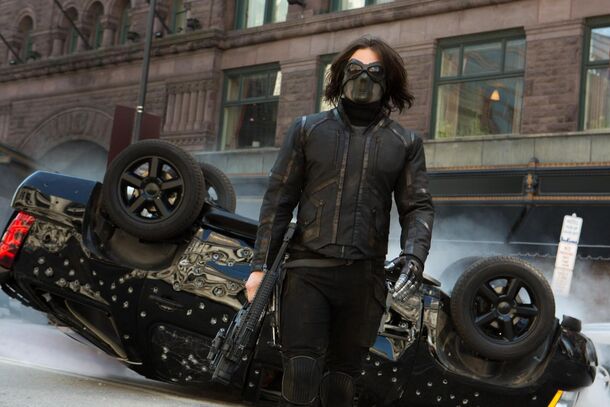How to Watch Marvel Movies in Chronological Order in 2022 Ahead of Black Panther 2 Release

Timelines in comic books were always tricky.
Things would be retconned, universes would merge, characters would be brought back to life just to die again. But with movies, that should be simpler – right?
Wrong.
Article after article has been written to explain the timeline of the Marvel Cinematic Universe. Some movies raise more questions than answers – Stark was recruiting for a team he hadn't yet joined in The Incredible Hulk; Spider-Man Homecoming completely ignored every other movie's setting and confused everybody.
Why is it so tough to nail this down? The answer is simple: The producers don't always know where they're going. They plan for one thing, such as the formation of the Avengers in Iron Man. Years later, an idea that hadn't previously thought about comes to fruition and they need to fit that character into the franchise's history, such as Fury thinking of the Avengers Initiative in the '90s at the end of Captain Marvel.
The more important question: Is it better to watch the movies as they came out, or in the order in which they're set?
Here's the complete list of the Marvel Cinematic Universe's movies along with the pros and cons of seeing them in this order.
Captain America: The First Avenger
A fitting way to start the franchise. Viewers would be introduced to the founders of SHIELD before Fury's mysterious cameo in Iron Man. We'd start our marvelous adventure with an Infinity Stone, we'd see Cap's shield as more than a foreshadow in Iron Man II, and we'd understand why Banner attempted to recreate the Super Soldier Serum in The Incredible Hulk. The Marvel Cinematic Universe would kick off in the 1940s with Steve Rogers – not Tony Stark – as the face of the franchise.
Captain Marvel
Jumping forward 50 years, the next superhero we meet is Captain Marvel. After his short cameo in Captain America, we now know intimately who Nick Fury is and the mystery of his missing eye – something that, if watched in real-time, would take 11 years to uncover. The story of the Tesseract is continued and put back to bed until 2012. Brie Larson becomes the second super-powered actor to grace the MCU, though we won't see her again for another decade.

Iron Man
The indie-style, improv-riddled phenomenon that spurred the MCU to life would no longer be our introduction to the franchise, but it would become something else – the movie that brings viewers back into real time. Would we lose a little something having met Howard Stark before Tony? Yes – but in this version, now we know what the heck the "Avenger Initiative" was that Fury spoke about in the post-credit scene, thanks to Captain Marvel.
Iron Man II, Thor, and Incredible Hulk
According to Marvel execs (and proven in What If… ep. 3), Abomination's attack, Hammer teaming up with Vanko, and Thor crashing into the Land of Enchantment all happen in the same week. (Remember Fury's business in the Southwest?) Chronologically, they all fall after Iron Man and set up five of our six original Avengers to join Captain America in the Battle of New York. Why the Incredible Hulk is on last place? It's the only reasonable excuse to have Stark speaking for the Avengers Initiative. That, or sloppy worldbuilding.
The Avengers
Captain America's awakening from his icy nap at the end of his origin film happens right before this movie kicks off. We know it's 2012 thanks to the time-traveling hijinks in Avengers: Endgame. It's team-up moment all of Phase One leads up to, but Captain Marvel's earlier placement begs the question: Where was she for the Chitauri invasion?
Iron Man III
Tony Stark suffers panic attacks after his nuclear ride into space. Set in the winter after the invasion, it's a 130-minute comedown from the intense world-building of Avengers before we get back to the Infinity Saga.
Thor: The Dark World
There's not much telling us about The Dark World's exact timeline besides "between Avengers and Age of Ultron, but it stands to reason that the conclusion of The Winter Soldier would directly lead to the very first scene of Age of Ultron.
Captain America: The Winter Soldier
The Winter Soldier swiftly removes SHIELD from the MCU, setting up the introduction of the next earthly adventure. It falls a few months after Iron Man III (being that winter has passed) and leads into the second Avengers team-up.

Guardians of the Galaxy
Guardians of the Galaxy Vol. 2
The first two films that took place away from the regular plotline both take place within a year of each other, despite their three-year difference in the release. Vol. 2 is set only several months after the first installment, which is confirmed to have been in 2014 via Avengers: Endgame.
Avengers: Age of Ultron, Ant-Man, Captain America: Civil War
These three happen sequentially after The Winter Soldier. Age of Ultron kicks off with the old team taking down Hydra bases and finishes with a brand new team, including newbie Falcon, stationed at a new Avengers complex. Ant-Man needs to follow, considering his quick spar with Falcon at the said complex. Civil War shows that new lineup in action before falling to pieces and setting up the final third of the Infinity Saga.
Black Widow
Released in 2021, the second female-led prequel takes place between the disbanding of the Avengers and Thanos' attack in Infinity War. Though the exact timeline is unclear, Natasha is shown fleeing from General Ross and his taskforce at the onset of the film. The only issue with rewatching in this order: Nat's death is absolutely spoiled.
Black Panther, Spider-Man: Homecoming
The two legendary characters in Civil War both got their solo movies over the next two years. T'Challa takes his crown after his father's death; Peter Parker learns what it takes to become an Avenger. It doesn't matter exactly where these two are watched, so long as it's between Civil War and Infinity War.
The only indication we have of where Doctor Strange begins on our MCU timeline is the phone call he gets about what we can only assume is Rhodey, who'd been paralyzed in Civil War. We can be certain of where it ends, as Strange makes an albeit quick appearance in Ragnarök.
Thor: Ragnarök, Ant-Man and the Wasp
These two movies, while wildly different, have one thing in common: A post-credit scene that leads directly to Infinity War. Thanos comes upon Thor's ship, which we find decimated in Infinity War. Scott Lang is stuck in the Quantum Realm after Infinity War's shocking conclusion, which would be a daunting peep forward into what would happen to our heroes if watched in this order.
Avengers: Infinity War, Avengers: Endgame
21 movies led us to this point, and everything since has come in its wake. Despite five years occurring between the two, the duo is basically the defining line of past and present MCU.
Eternals, Shang-Chi and the Legend of the Ten Rings
Both films make mention of the blip, though it's a more crucial plot point of Eternals. Neither has a particularly set timeline, but it makes sense coming before Spider-Man makes his post-blip entrance.
The latest entry to the MCU is among the trickiest to sort among our timeline. We know it follows Endgame, as Thor has joined the Guardians of the Galaxy. For how long were they adventuring? This is more of a guess, placing it this early, but it's sure to be sorted by the time GOTG Vol 3. Releases.
Spider-Man: Far From Home
Spider-Man: No Way Home
Far From Home takes place the semester following the second snap. Having been released directly after Endgame, it spends a lot of time explaining the in-universe reaction to the blip. It should come after Shang-Chi and Eternals, given how understanding and content the characters have become since the blip; it had likely been several months. No Way Home begins seconds after Far From Home's post-credit scene, meaning viewers waited two years to see Peter's reaction to his unmasking.
Doctor Strange in the Multiverse of Madness
WandaVision should certainly be watched before Doctor Strange's horror-inspired follow-up, but just among the movies, all we know is that it comes after No Way Home. Strange had just helped Peter with another multiversal mix-up, which he'd mentioned throughout the film.
We have five movies that left us yet unresolved. Multiverse of Madness and Eternals left viewers on a cliffhanger. How soon will it be resolved? Where does Doctor Strange go? Do the Eternals stay captured? No Way Home, Love and Thunder, and Shang-Chi all cheerily set up future films.
As before, the universe will continue to expand with many seemingly unrelated branches of plotlines and hero work before logically fitting together into a singular timeline, a timeline that will be fully understood by 2025 with the release of the next Avengers.
What do you think? Should the Marvel Cinematic Universe be watched as released or chronologically?